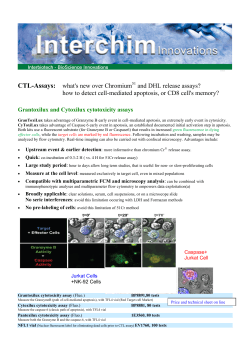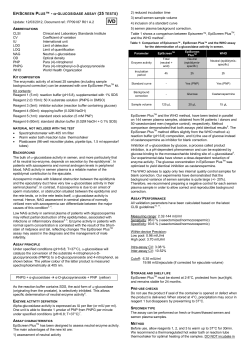
Document 272696
Evaluationof a Sample-Preparation
Procedure for Bile Acids in Serum
and Bile
5. Mashige
F, Imai K, Osuga T. A simple
and sensitive assay of total serum bile acids.
Ibid. 70, 79-86 (1976).
D. Feldmann
C Fenech
J. F. Cuer
To the Editor:
Extraction of bile acids from biological samples is laborious and time consuming. Recently the use of columns
packed with octadecylsilane
bonded
phase (Sep-Pak C18 Cartridge; Waters
Associates, Inc.) has been reported in
various procedures (1-4), but the capacity of the column and the analytical
recovery of the bile acids were not
Lab. &Biochim.
H#{244}pital
Trousseau
75571 Paris Cedc
France
12
References
1. Kineiko RW, Floering DA, Morrissey M.
Laboratory evaluation of the Boehringer
Mannheim “Hitachi 705” automatic analyzer. Clin Chem 29, 688-691 (1983).
described.
We report here our results on using
the following procedure: Wash the SepPak column successively
with 10 mL of
water, 10 mL of methanol,
10 mL of
water, and 3 mL of Tris buffer, pH 9.
Pass the sample of serum or bile, diluted 10-fold with the buffer, through the
column with a flow rate of about 0.5
mL/min, and wash with water until
the pH of the effluent is neutral. Elute
the bile acids with 3 mL of methanol,
collect the eluate, evaporate it, and
dissolve the residue in a suitable volume of methanol.
We measured the bile acids in samples by the enzymatic 3a-hydroxysteroid dehydrogenase
method (5). Withinrun precision data were: X = 55 molJ
L, SD = 1.58 p,moIJL, CV = 2.8%.
Analytical
recovery was X = 89.9%,
SD = 2.9%, n = 12, for 10 to 450 nmol
of bile acids.
This sample preparation
is also suitable before further identifying bile acids by gas-chromatography.
This method of sample preparation
has the advantages
that emulsions
such as occur during liquid-liquid
extraction
are avoided, capacities and
flow rates of the columns are greater
than with Aniberlite
XAD2 columns,
and coiijugated
and free bile acids are
recovered simultaneously.
References
1. Goto J, Kato H, Saruta Y, Nambara T.
Separation and determination of bile acids
in human bile by high-performance liquid
chromatography. J Liq Chromatogr 3,9911003 (1980).
2. Linnet K. A high-pressure
liquid chromatographic-enzymatic
assay for glycine
and taurine conjugates of cholic, chenodeoxycholic and deoxycholic acid in serum.
ScandJ Clin Lab Invest 42,455-460(1982).
3. Ruben AT, Van Berge-Henegouwen
GP.
A simple reverse-phase high pressure liquid
chromatographic
determination of conjugated bile acids in serum and bile using a
novel radial compression
separation
system. Clin Chim Acta 119, 44-50 (1982).
4. Setchell KDR, Worthington
J. A rapid
method for the quantitative extraction of
bile acids and their conjugates from serum
using commercially available reverse-phase
octadecylsilane bounded silica cartridges.
Clin Chim Acta 125, 135-144 (1982).
lands was contacted about these problems. They solved all reagent carryover effects by adding WAK-System
Clean (a detergent produced by WAKChemie GmbH., Bad Soden, F.R.G.,
and sold by Boehringer Mannheim) to
the rinsing water in a concentration of
5 gIL. Copper contamination was overcome by selecting an EDTA-biuret
method.
Carryoverand the Hitachi705
2. Douville P, Forest JC. Performance of
the Hitachi 705 evaluated. Ciin Chem 29,
To the Editor:
692-696
I read with interest the two papers
(1,2) on evaluation of the Hitachi 705.
This instrument
has been used in our
3. Gosling P, Legg EF, Sainmons HG. pHdependent adsorption of calcium onto stainless steel. Clin Chem 25, 1336 (1979). Letter.
laboratory for a year, and we now find
it essential-but
one must be careful.
In both papers, carryover
was assessed and considered excellent. I do
not agree completely. The metal sample pipet may act as a pH-dependent
ion exchanger (3, 4). Therefore,
the
accufacy of a calcium assay is affected
by the pH of the preceding
and the
actual sample.
Because the Hitachi 705, a computer-controlled discrete analyzer, is capable of running all combination profiles
and single test modes, reagent carryover should be extremely low, since
every possible sequence of reagent addition may and will occur. In this context, I encountered some other problems.
1. Reagents for alanine and aspartate aininotransferases
contain lactate
dehydrogenase
(LD). This enzyme is
absorbed
onto the wall of the reagent
pipettor. The normal washing between
adjacent pipettings
is insufficient.
Some U) will be eluted into the next
cuvette, and the LD assay result for
this cuvette will be increased by several hundred UIL.
2. The diazo reagent used in the
Jendrassik-Grof
very
bilirubin
assay
is
to traces of copper.
Biuret contains
excessive amounts
of
copper. After a protein assay, as many
as three successive pipettings are contaminated with copper. Moreover, copper adheres
to the cuvette wall. After
the normal cuvette washings the cuvette is still contaminated.
3. Other such combinations
are
known that potentially can cause trouble, such as an inorganic phosphate
assay preceded by a phosphate buffer
and a triglyceride assay preceded by a
urea N assay in which urease in glycerol is used.
The Instrument Division of Boshringer Mannheim B.V. The Nether-
1694 CLINICALCHEMISTRY, Vol. 29, No. 9, 1983
sensitive
(1983).
4. Liodtke RJ, Kroon G, Baijer JD. Centrifugal analysis with automated reagent addition: Measurement
of serum calcium. C/in
Chein 27, 2025-2028 (1981).
C P. Degenaar
Lab. of Clin. Chem.
St. Annadal
Hospital
6201 BX Maastricht
The Netherlands
Standardization of the Coiorimetrlc
Assayfor GlycosylatedHemoglobin
To the Editor:
Over the past few years, estimation
of glycosylated proteins (notably hemoglobin) has been widely used to monitor metabolic control in diabetes mellitus. To avoid the problems inherent in
the commonly used chromatographic
methods of glycosylated
hemoglobin
(GHb) measurement
(1), considerable
attention has been given to refining a
colorimetric method that involves thiobarbituric acid complexation with 5hydroxymethylfurfural
(HMF) produced by acid hydrolysis of ketoaminelinked
sugar
(2). However,
the
colorimetric method is difficult to standardize. Pure HMF standards
are not
satisfactory because they are heat labile and do not monitor the important
hydrolysis
step. Fructose
undergoes
conversion to HMF under conditions of
the test, and so the use of fructose
standards
would appear to be a logical
compromise.
But a major criticism
of
this approach is that the rate of HMF
production
from fructose
differs from
© Copyright 2025




















